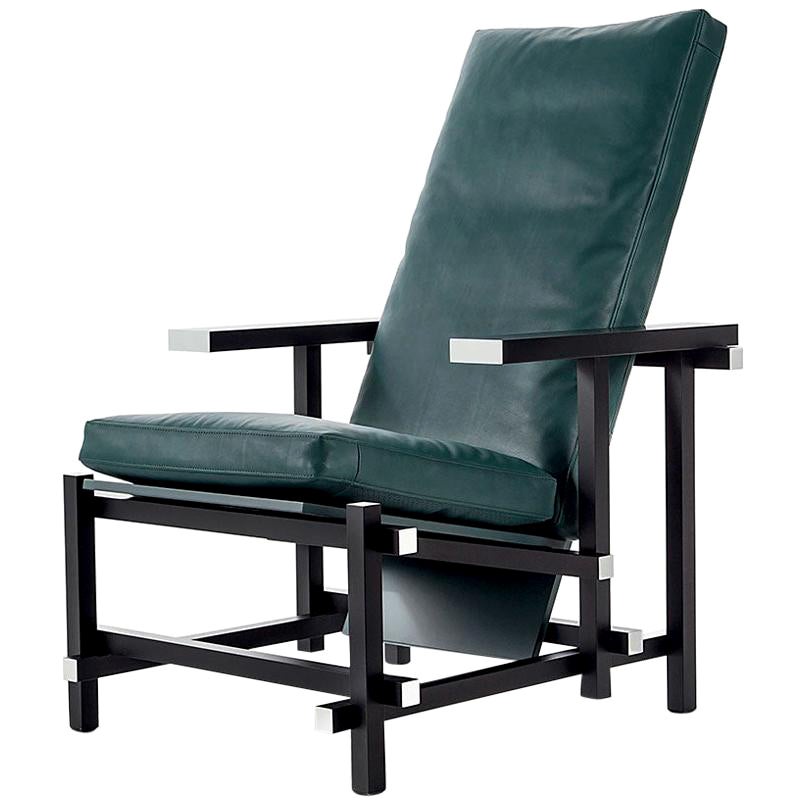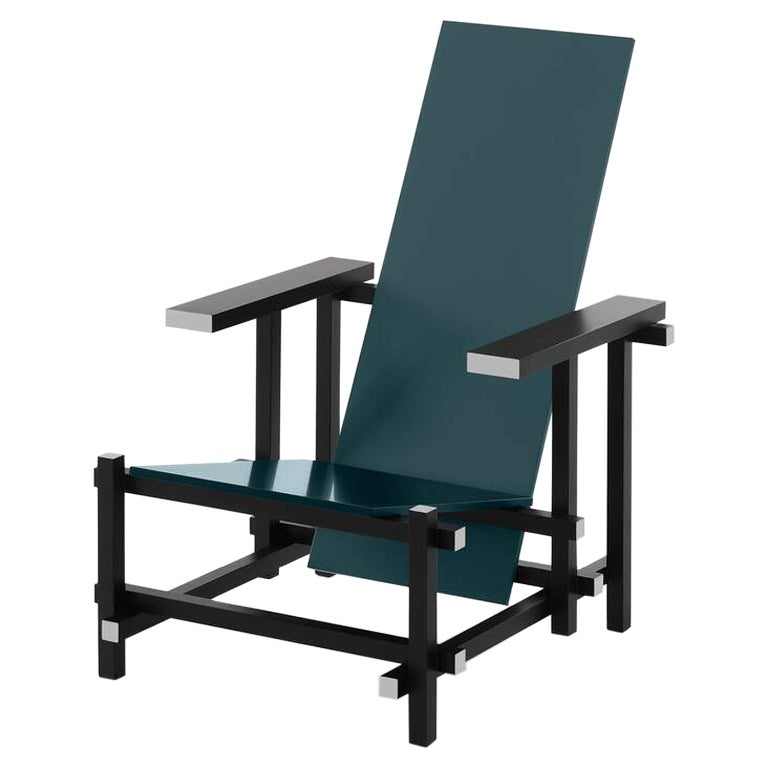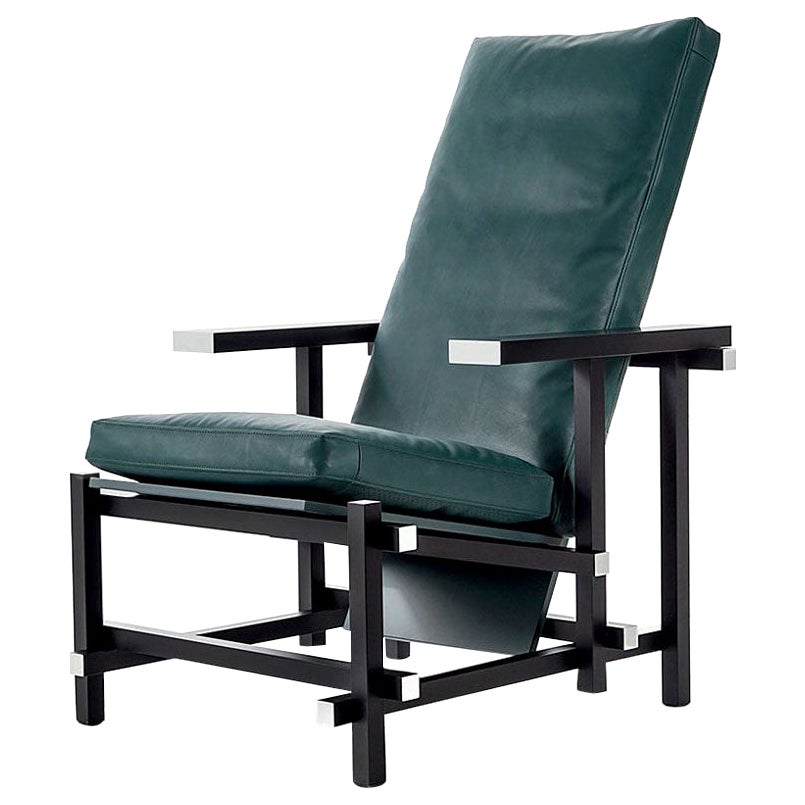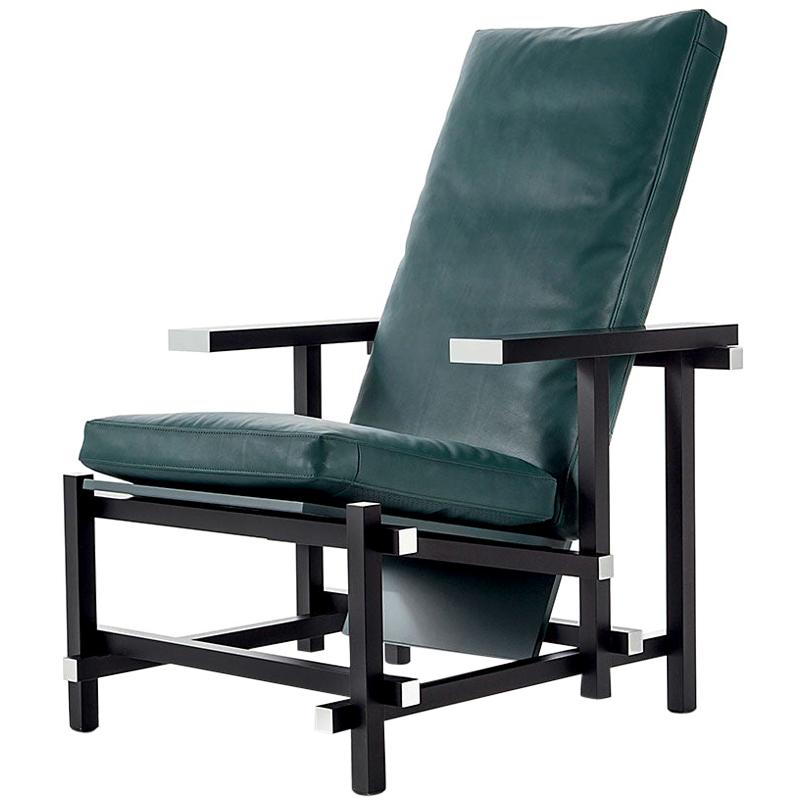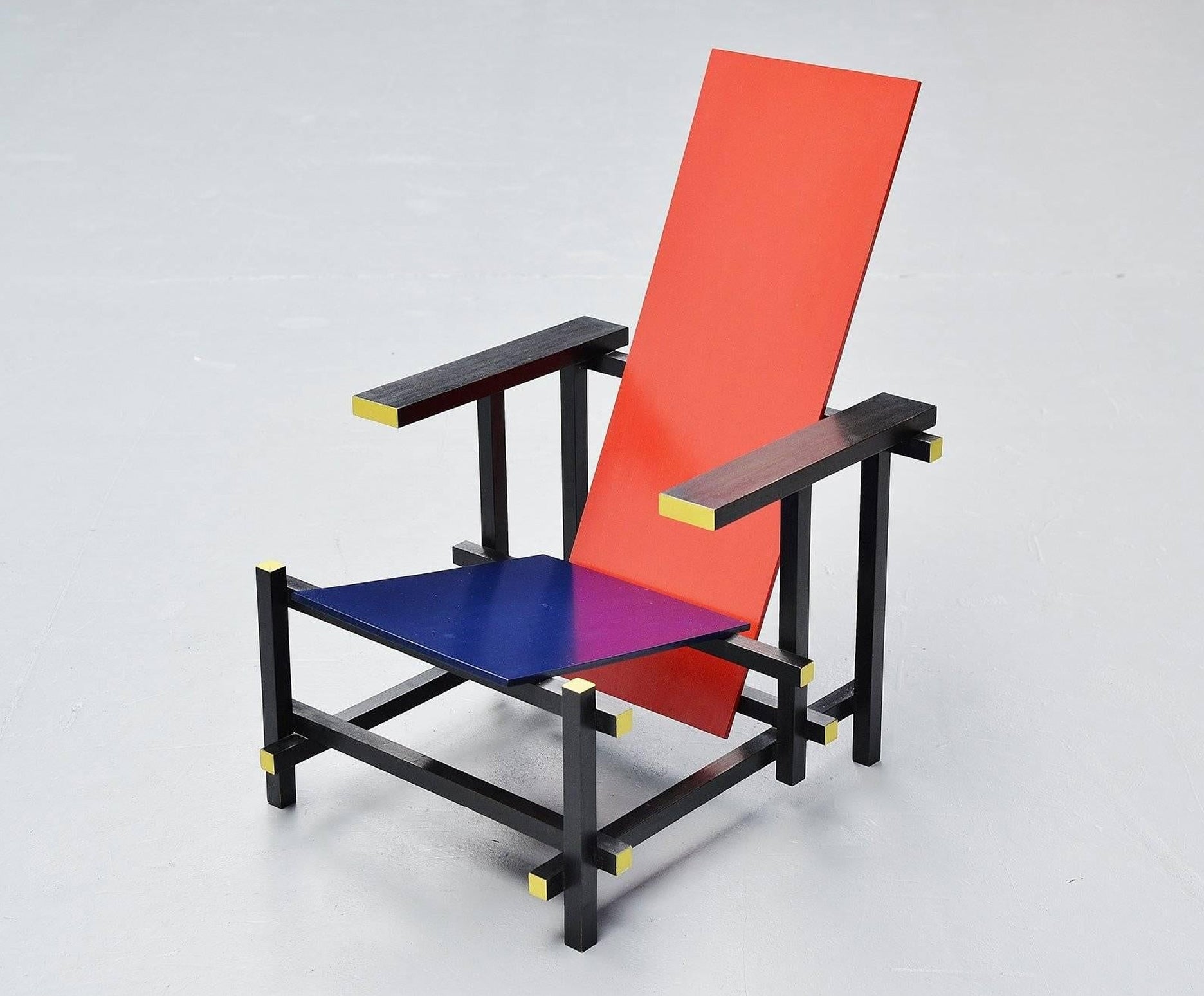Italian Bauhaus Armchair Red and Blue by Rietveld 1st production Cassina 1971
About the Item
- Creator:Gerrit Rietveld (Designer),Cassina (Manufacturer)
- Design:
- Dimensions:Height: 34.45 in (87.5 cm)Width: 25.99 in (66 cm)Depth: 35.44 in (90 cm)Seat Height: 12.21 in (31 cm)
- Style:Bauhaus (Of the Period)
- Materials and Techniques:
- Place of Origin:
- Period:
- Date of Manufacture:1971
- Condition:Wear consistent with age and use. Good condition, it has small color flaws and some scattered marks on the wood.
- Seller Location:MIlano, IT
- Reference Number:1stDibs: LU4860236160592
Red and Blue Chair
With its geometric composition and primary colors, the Red and Blue armchair has become the definitive symbol of the Dutch De Stijl (“the Style”) movement. The chair’s creator, Gerrit Rietveld (1888–1964), was perhaps an unlikely pioneer of this revolutionary aesthetic movement given his traditional path to making furniture. The son of a carpenter in Utrecht, Rietveld left school at age 11 to begin an apprenticeship with his father. Later, he attended night school and worked for a goldsmith. In 1917, Rietveld opened his own furniture workshop.
Although he trained as a cabinetmaker, Rietveld’s interests eventually grew beyond craftsmanship, and he began to focus closely on the intellectual concepts of design. He built objects from minimal materials and believed that a chair could provide more than rest for the body; the greater goal — the one he set for this chair — was to provide for the “well-being and comfort of the spirit.” On the underside of the seat he inscribed, “When I sit, I do not want to sit as my seated flesh likes, but rather as my seated spirit would sit, if it wove the chair for itself.”
Designed in 1918, the original Red and Blue armchair was neither red nor blue — it was made of beechwood. But in its geometric precision, the piece embodied the modernist De Stijl philosophy to achieve postwar harmony through a rigorous aesthetic of pairing basic shapes with a minimal color palette. Rietveld designed the chair using only wood that had been cut in standard, readily available sizes. In doing so, he hoped it would one day be mass produced. This move toward an ethos of industrialization was pure De Stijl, and would later influence movements like Bauhaus and International Style. Writer and architect Theo van Doesburg, who cofounded the movement with the artist Piet Mondrian, featured Rietveld’s chair in De Stijl, the magazine he edited and published that launched alongside the Dutch movement.
It wasn’t until approximately 1923 that Rietveld painted the chair in the colors it is known for today — the colors most frequently associated with Mondrian and De Stijl. In addition to furniture and decorative objects, Rietveld designed 100 buildings throughout his career but only one outside the Netherlands. By far the most important is the Rietveld Schröder House (1924), considered the only house built completely on De Stijl precepts. Cassina manufactures the Red and Blue chair today, and the ingenious simplicity of Rietveld’s construction continues to challenge designers as often as it delights them.
Gerrit Rietveld
Best known for his Red and Blue chair, a modernist icon created using only two plywood plates and 15 connecting bars, Dutch designer Gerrit Thomas Rietveld trained as a cabinetmaker, and his bold vision for furniture was supported by his expertise in construction and craftsmanship.
Born in Utrecht, Rietveld learned goldsmithing in addition to the cabinetry apprenticeship he had in his carpenter father’s workshop. He studied draftsmanship with architect Piet Klaarhamer at the Utrecht Museum of Applied Arts and opened his own furniture workshop in 1917. In the 1930s, Rietveld began to experiment with then-unusual materials like plywood and aluminum, and he pursued intellectual concepts through his design, even considering a seat as a resting place for the body and the soul.
Designed in 1918, the minimalist Red and Blue chair is widely coveted by collectors and gained admirers in the likes of legendary American sculptor and designer Donald Judd over the years. (Examples of Rietveld’s designs can be found in Judd’s restored home-museum in New York City.) The Red and Blue chair is so stunning in its geometric simplicity that it is one of the most important symbols of the Dutch art and design movement of the early 20th century called De Stijl, of which Rietveld was an important part. De Stijl means “the Style” and was an effort to express utopian values through pure abstraction in design and the use of primary colors.
Another example of Rietveld’s celebrated seating furniture is the Zig-Zag chair, which was commissioned by the Dutch department store Metz & Co. and intended to be mass-produced. The resulting design — to which the rights to manufacture were bought by Cassina in 1971 — is the essence of the De Stijl movement and an example of Rietveld’s experiments with jointless chairs made from a single material, wood. The Zig-Zag chair’s armless, legless, elegant form is pure abstraction, yet it is also sturdy and comfortable.
Later in his career, Rietveld worked more often as an architect, designing buildings in prestigious settings like the Venice Biennale. He was a pioneer in more ways than one: The first building he designed, Rietveld Schröder House in Utrecht in 1924, is a radically modern space and has been a UNESCO World Heritage Site since 2000.
Find vintage Gerrit Rietveld furniture on 1stDibs.
- ShippingRetrieving quote...Ships From: Milano, Italy
- Return PolicyA return for this item may be initiated within 14 days of delivery.
- Italian Bauhaus Solid Wood Crate Table by Gerrit Rietveld for Cassina, 1980sBy Gerrit Rietveld, CassinaLocated in MIlano, ITItalian Bauhaus solid wood crate table by Gerrit Rietveld for Cassina, 1980s Crate series table, with top formed by parallel solid wood boards and with cro...Category
Vintage 1980s Italian Bauhaus Dining Room Tables
MaterialsWood
- Italian modern Velvet sofa Utrecht by Gerrit Thomas Rietveld for Cassina , 1990sBy Gerrit Rietveld, CassinaLocated in MIlano, ITItalian modern Velvet sofa mod. Utrecht by Gerrit Thomas Rietveld for Cassina , 1990s fantastic three-seater sofa mod. Utrecht with curved seat and backrest, padded and upholstered ...Category
1990s Italian Modern Sofas
MaterialsVelvet
- Italian Leggera chair in wood and red fabric by Gio Ponti for Cassina, 1951By Gio Ponti, CassinaLocated in MIlano, ITLeggera model chair with black stained beech wood frame, with upholstered seat covered in red fabric. Design by Gio Ponti, for Cassina, 1951. The Leggera chair represent one of the m...Category
Vintage 1950s Italian Mid-Century Modern Chairs
MaterialsFabric, Wood
- Italian Set of Red Villabianca Chairs by Vico Magistretti for Cassina, 1985By Vico Magistretti, CassinaLocated in MIlano, ITItalian Mid-Century Modern set of red and black Villabianca chairs by V. Magistretti for Cassina, 1985 Set of 4 Villabianca chairs, with round section beech frame and graphic line o...Category
Vintage 1980s Italian Mid-Century Modern Chairs
MaterialsFabric, Wood
- Italian mid-century modern Chair Carimate by Vico Magistretti for Cassina, 1970sBy Vico Magistretti, CassinaLocated in MIlano, ITItalian mid-century modern Chair Carimate by Vico Magistretti for Cassina, 1970s Chair mod. Carimate in white lacquered wood with glossy finish and seat, padded and covered in red f...Category
Vintage 1970s Italian Mid-Century Modern Chairs
MaterialsFabric, Wood
- Italian mid-century modern chairs 122 by Vico Magistretti for Cassina, 1960sBy Cassina, Vico MagistrettiLocated in MIlano, ITItalian mid-century modern chairs 122 by Vico Magistretti for Cassina, 1960s Set of four chairs mod. 122 with brown leather seat. The structure is entirely made of wood, the backrest...Category
Vintage 1960s Italian Mid-Century Modern Chairs
MaterialsLeather, Wood
- Gerrit Rietveld Red and Blue Chair by CassinaBy Gerrit Rietveld, CassinaLocated in Barcelona, BarcelonaChair designed by Gerrit Rietveld in 1918. Relaunched in 1973. Manufactured by Cassina in Italy. A sculptural seat with a pure and rationalist form, this chair became an authenti...Category
2010s Italian Mid-Century Modern Armchairs
MaterialsWood
- Gerrit Rietveld Red and Blue Chair for Cassina, Italy, newBy Cassina, Gerrit RietveldLocated in Berlin, DEChair designed by Gerrit Rietveld in 1918. Relaunched in 1973. Manufactured by Cassina in Italy.Category
21st Century and Contemporary Italian Chairs
MaterialsWood
- Gerrit Rietveld Zeilmaker Version of Black Red and Blue Chair by CassinaBy Gerrit Rietveld, CassinaLocated in Barcelona, BarcelonaChair designed by Gerrit Rietveld in 1920. Relaunched in 2015. Manufactured by Cassina in Italy. One of the versions of the iconic model dated 1918. The structure is in black-stained beechwood with white contrasting parts. Seat and back in green lacquered multiplywood. The armchair can have a single seat and backrest cushion in fabric or leather. The black red and blue (Zeilmaker version) born from Rietveld’s chromatic experimentation While researching the origins of the red and blue model in collaboration with the Rietveld heirs, it emerged that the key idea of the first prototypes was based on the concept of spatial organization expressed through the monochrome tones of its elements. The first version was in fact produced in 1918 in completely unpainted wood. In the following years Rietveld proposed various examples, either monochrome or painted in different colors, depending on the requirements of his customers and the interiors for which the chairs were intended. As such, it comes as no surprise to find this 1920s version, presented as part of Cassina’s MutAzioni selection, created for the school teacher Wicher Zeilmaker with a black frame with white ends and a dark green painted seat and backrest. It was Rietveld’s ever-increasing involvement in the De Stijl movement that led him to also use primary colors on this model in 1923, and as such the chair became a veritable manifesto for the emerging neoplastic movement. Initially dubbed slat chair, Rietveld only gave it the name red and blue in the 1950s following its chromatic evolution. The various owners of the different examples used the chair as an abstract-realist sculpture in their interiors and, in some cases, as a simple tool for sitting on, adding cushions to make it more comfortable, just like Cassina offers for the black red and blue today. Important information regarding images of products: Please note that some of the images show other colors and variations of the model, these images are only to present interior design proposals. The item that is selling is on the first image. Important information regarding color(s) of products: Actual colors may vary. This is due to the fact that every computer monitor, laptop, tablet and phone screen has a different capability to display colors and that everyone sees these colors differently. We try to edit our photos to show all of our products as life-like as possible, but please understand the actual color may vary slightly from your monitor About the designer: Gerrit Thomas Rietveld, born in Utrecht on 24 June 1888, seems possessed of two personalities, each so distinct that one might take his work to be that of more than one artist. The first personality is that seen in the craftsman cabinet-maker working in a primordial idiom, re-inventing chairs and other furniture as if no one had ever built them before him and following a structural code all of his own; the second is that of the architect working with elegant formulas, determined to drive home the rationalist and neoplastic message in the context of European architecture. The two activities alternate, overlap, and fuse in a perfect osmosis unfolding then into a logical sequence. In 1918 Rietveld joined the “De Stijl” movement which had sprung up around the review of that name founded the year before by Theo van Doesburg. The group assimilated and translated into ideology certain laws on the dynamic breakdown of compositions (carrying them to an extreme) that had already been expressed in painting by the cubists: the “De Stijl” artists also carefully studied the architectonic lesson taught by the great Frank Lloyd Wright, whose influence was widely felt in Europe at that time. Collaborating first with Robert van’t Hoff and Vilmos Huszar...Category
2010s Italian Mid-Century Modern Armchairs
MaterialsLeather, Wood
- Gerrit Rietveld Zeilmaker Version of Black Red and Blue Chair by CassinaBy Gerrit Rietveld, CassinaLocated in Barcelona, BarcelonaChair designed by Gerrit Rietveld in 1920. Relaunched in 2015. Manufactured by Cassina in Italy. One of the versions of the iconic model dated 1918. The structure is in black-stained beechwood with white contrasting parts. Seat and back in green lacquered multiplywood. The black red and blue (Zeilmaker version) born from Rietveld’s chromatic experimentation While researching the origins of the red and blue model in collaboration with the Rietveld heirs, it emerged that the key idea of the first prototypes was based on the concept of spatial organization expressed through the monochrome tones of its elements. The first version was in fact produced in 1918 in completely unpainted wood. In the following years Rietveld proposed various examples, either monochrome or painted in different colors, depending on the requirements of his customers and the interiors for which the chairs were intended. As such, it comes as no surprise to find this 1920s version, presented as part of Cassina’s MutAzioni selection, created for the school teacher Wicher Zeilmaker with a black frame with white ends and a dark green painted seat and backrest. It was Rietveld’s ever-increasing involvement in the De Stijl movement that led him to also use primary colors on this model in 1923, and as such the chair became a veritable manifesto for the emerging neoplastic movement. Initially dubbed slat chair, Rietveld only gave it the name red and blue in the 1950s following its chromatic evolution. The various owners of the different examples used the chair as an abstract-realist sculpture in their interiors and, in some cases, as a simple tool for sitting on, adding cushions to make it more comfortable, just like Cassina offers for the black red and blue today. Important information regarding images of products: Please note that some of the images show other colors and variations of the model, these images are only to present interior design proposals. The item that is selling is on the first image. Important information regarding color(s) of products: Actual colors may vary. This is due to the fact that every computer monitor, laptop, tablet and phone screen has a different capability to display colors and that everyone sees these colors differently. We try to edit our photos to show all of our products as life-like as possible, but please understand the actual color may vary slightly from your monitor About the designer: Gerrit Thomas Rietveld, born in Utrecht on 24 June 1888, seems possessed of two personalities, each so distinct that one might take his work to be that of more than one artist. The first personality is that seen in the craftsman cabinet-maker working in a primordial idiom, re-inventing chairs and other furniture as if no one had ever built them before him and following a structural code all of his own; the second is that of the architect working with elegant formulas, determined to drive home the rationalist and neoplastic message in the context of European architecture. The two activities alternate, overlap, and fuse in a perfect osmosis unfolding then into a logical sequence. In 1918 Rietveld joined the “De Stijl” movement which had sprung up around the review of that name founded the year before by Theo van Doesburg. The group assimilated and translated into ideology certain laws on the dynamic breakdown of compositions (carrying them to an extreme) that had already been expressed in painting by the cubists: the “De Stijl” artists also carefully studied the architectonic lesson taught by the great Frank Lloyd Wright, whose influence was widely felt in Europe at that time. Collaborating first with Robert van’t Hoff and Vilmos Huszar, then with Theo van Doesburg and Cornelius van Eesteren, Rietveld soon became one of the most distinguished interpreters of the neoplastic message. Among his most important works are: the Schröder house at Utrecht (1924); the “Row Houses” at Utrecht (1931-1934); the Dutch pavilion at the Venice Biennial (1954); the sculpture pavilion in the Rijksmuseum Kröller-Müller at Otterloo and the Van Gogh Museum in Amsterdam (1955). Out of his equally important furniture, Cassina has chosen for its own production: the “Red and Blue” (1918), the “Zig-Zag” (1934), the “Schröder 1...Category
2010s Italian Mid-Century Modern Armchairs
MaterialsLeather, Wood
- Gerrit Rietveld Zeilmaker Version of Black Red and Blue Chair by CassinaBy Gerrit Rietveld, CassinaLocated in Barcelona, BarcelonaChair designed by Gerrit Rietveld in 1920. Relaunched in 2015. Manufactured by Cassina in Italy. One of the versions of the iconic model dated 1918. The structure is in black-stained beechwood with white contrasting parts. Seat and back in green lacquered multiplywood. The armchair can have a single seat and backrest cushion in fabric or leather. The black red and blue (Zeilmaker version) born from Rietveld’s chromatic experimentation While researching the origins of the red and blue model in collaboration with the Rietveld heirs, it emerged that the key IDEA of the first prototypes was based on the concept of spatial organization expressed through the monochrome tones of its elements. The first version was in fact produced in 1918 in completely unpainted wood. In the following years Rietveld proposed various examples, either monochrome or painted in different colors, depending on the requirements of his customers and the interiors for which the chairs were intended. As such, it comes as no surprise to find this 1920s version, presented as part of Cassina’s MutAzioni selection, created for the school teacher Wicher Zeilmaker with a black frame with white ends and a dark green painted seat and backrest. It was Rietveld’s ever-increasing involvement in the De Stijl movement that led him to also use primary colors on this model in 1923, and as such the chair became a veritable manifesto for the emerging neoplastic movement. Initially dubbed slat chair, Rietveld only gave it the name red and blue in the 1950s following its chromatic evolution. The various owners of the different examples used the chair as an abstract-realist sculpture in their interiors and, in some cases, as a simple tool for sitting on, adding cushions to make it more comfortable, just like Cassina offers for the black red and blue today. Important information regarding images of products: Please note that some of the images show other colors and variations of the model, these images are only to present interior design proposals. The item that is selling is on the first image. Important information regarding color(s) of products: Actual colors may vary. This is due to the fact that every computer monitor, laptop, tablet and phone screen has a different capability to display colors and that everyone sees these colors differently. We try to edit our photos to show all of our products as life-like as possible, but please understand the actual color may vary slightly from your monitor About the designer: Gerrit Thomas Rietveld, born in Utrecht on 24 June 1888, seems possessed of two personalities, each so distinct that one might take his work to be that of more than one artist. The first personality is that seen in the craftsman cabinet-maker working in a primordial idiom, re-inventing chairs and other furniture as if no one had ever built them before him and following a structural code all of his own; the second is that of the architect working with elegant formulas, determined to drive home the rationalist and neoplastic message in the context of European architecture. The two activities alternate, overlap, and fuse in a perfect osmosis unfolding then into a logical sequence. In 1918 Rietveld joined the “De Stijl” movement which had sprung up around the review of that name founded the year before by Theo van Doesburg. The group assimilated and translated into ideology certain laws on the dynamic breakdown of compositions (carrying them to an extreme) that had already been expressed in painting by the cubists: the “De Stijl” artists also carefully studied the architectonic lesson taught by the great Frank Lloyd Wright, whose influence was widely felt in Europe at that time. Collaborating first with Robert van’t Hoff and Vilmos Huszar, then with Theo van Doesburg and Cornelius van Eesteren, Rietveld soon became one of the most distinguished interpreters of the neoplastic message. Among his most important works are: the Schröder house at Utrecht (1924); the “Row Houses” at Utrecht (1931-1934); the Dutch pavilion at the Venice Biennial (1954); the sculpture pavilion in the Rijksmuseum Kröller-Müller at Otterloo and the Van Gogh Museum in Amsterdam (1955). Out of his equally important furniture, Cassina has chosen for its own production: the “Red and Blue” (1918), the “Zig-Zag” (1934), the “Schröder 1...Category
2010s Italian Mid-Century Modern Armchairs
MaterialsLeather, Wood
- Gerrit Rietveld Zeilmaker Version of Black Red and Blue Chair by CassinaBy Gerrit Rietveld, CassinaLocated in Barcelona, BarcelonaChair designed by Gerrit Rietveld in 1920. Relaunched in 2015. Manufactured by Cassina in Italy. One of the versions of the iconic model dated 1918. The structure is in black-stained beechwood with white contrasting parts. Seat and back in green lacquered multiplywood. The armchair can have a single seat and backrest cushion in fabric or leather. The black red and blue (Zeilmaker version) born from Rietveld’s chromatic experimentation While researching the origins of the red and blue model in collaboration with the Rietveld heirs, it emerged that the key idea of the first prototypes was based on the concept of spatial organization expressed through the monochrome tones of its elements. The first version was in fact produced in 1918 in completely unpainted wood. In the following years Rietveld proposed various examples, either monochrome or painted in different colors, depending on the requirements of his customers and the interiors for which the chairs were intended. As such, it comes as no surprise to find this 1920s version, presented as part of Cassina’s MutAzioni selection, created for the school teacher Wicher Zeilmaker with a black frame with white ends and a dark green painted seat and backrest. It was Rietveld’s ever-increasing involvement in the De Stijl movement that led him to also use primary colors on this model in 1923, and as such the chair became a veritable manifesto for the emerging neoplastic movement. Initially dubbed slat chair, Rietveld only gave it the name red and blue in the 1950s following its chromatic evolution. The various owners of the different examples used the chair as an abstract-realist sculpture in their interiors and, in some cases, as a simple tool for sitting on, adding cushions to make it more comfortable, just like Cassina offers for the black red and blue today. Production delay: 8-9 weeks Important information regarding images of products: Please note that some of the images show other colors and variations of the model, these images are only to present interior design proposals. The item that is selling is on the first image. Important information regarding color(s) of products: Actual colors may vary. This is due to the fact that every computer monitor, laptop, tablet and phone screen has a different capability to display colors and that everyone sees these colors differently. We try to edit our photos to show all of our products as life-like as possible, but please understand the actual color may vary slightly from your monitor About the designer: Gerrit Thomas Rietveld, born in Utrecht on 24 June 1888, seems possessed of two personalities, each so distinct that one might take his work to be that of more than one artist. The first personality is that seen in the craftsman cabinet-maker working in a primordial idiom, re-inventing chairs and other furniture as if no one had ever built them before him and following a structural code all of his own; the second is that of the architect working with elegant formulas, determined to drive home the rationalist and neoplastic message in the context of European architecture. The two activities alternate, overlap, and fuse in a perfect osmosis unfolding then into a logical sequence. In 1918 Rietveld joined the “De Stijl” movement which had sprung up around the review of that name founded the year before by Theo van Doesburg. The group assimilated and translated into ideology certain laws on the dynamic breakdown of compositions (carrying them to an extreme) that had already been expressed in painting by the cubists: the “De Stijl” artists also carefully studied the architectonic lesson taught by the great Frank Lloyd Wright, whose influence was widely felt in Europe at that time. Collaborating first with Robert van’t Hoff and Vilmos Huszar, then with Theo van Doesburg and Cornelius van Eesteren, Rietveld soon became one of the most distinguished interpreters of the neoplastic message. Among his most important works are: the Schröder house at Utrecht (1924); the “Row Houses” at Utrecht (1931-1934); the Dutch pavilion at the Venice Biennial (1954); the sculpture pavilion in the Rijksmuseum Kröller-Müller at Otterloo and the Van Gogh Museum in Amsterdam (1955). Out of his equally important furniture, Cassina has chosen for its own production: the “Red and Blue” (1918), the “Zig-Zag” (1934), the “Schröder 1...Category
2010s Italian Mid-Century Modern Armchairs
MaterialsWood, Leather
Recently Viewed
View AllRead More
The 21 Most Popular Mid-Century Modern Chairs
You know the designs, now get the stories about how they came to be.
Billy Cotton Layers His Interiors with Lived-In Comfort
The Brooklyn-based designer is adept at styles ranging from austere to over-the-top, espousing an architectural, detail-oriented approach also evident in his line of furniture and lighting.


